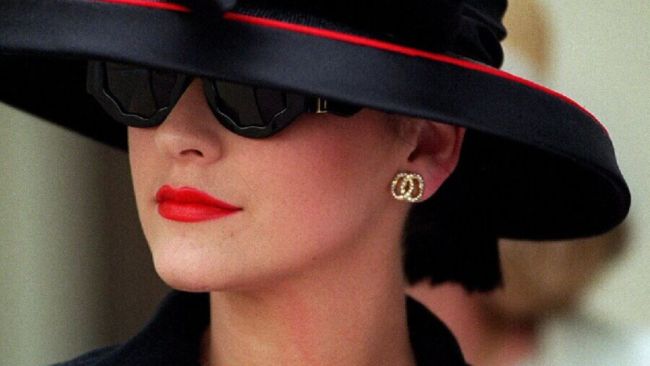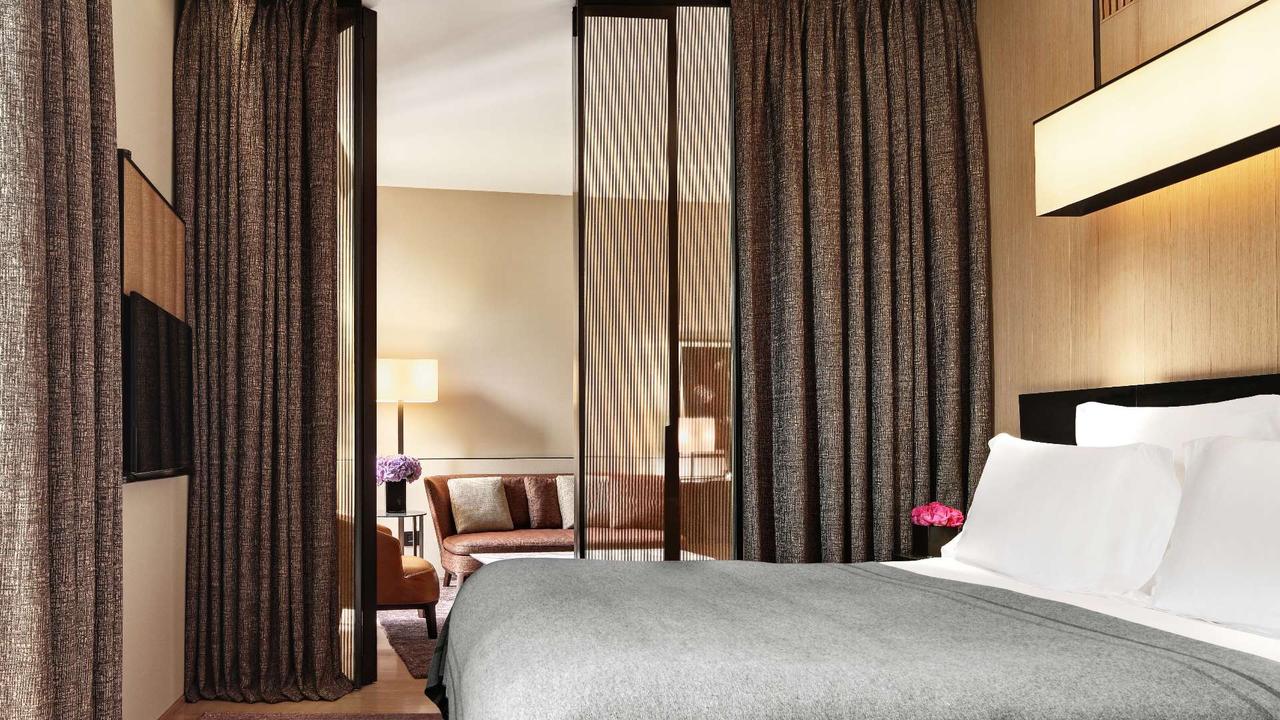Lanvin’s fashion legacy revisited by Alber Elbez for Paris exhibition
Little is known about Jeanne Lanvin, but this glamorous retrospective in Paris reveals her brilliance and virtuoso.

You only have to look at the success of Wolf Hall, Downton Abbey, a third of Hollywood’s output or the British royal family to know that history is big business.
In fashion, it’s even bigger. Isn’t that a paradox? A medium that’s meant to be restlessly forward-looking is caught in a cycle of nostalgia. The next big thing invariably turns out to be a re-release. It’s not necessarily a sign of creative exhaustion (although that’s a factor in some design studios) so much as a perspective that enables us to explore who we are today — and what we want to be tomorrow.
When designer Raf Simons went to Dior, for instance, one of the first things he did was re-establish the house codes. That first couture collection of his, shown in the summer of 2012, was a deftly edited equivalent of a coat of arms. Look, it said, this is what we do: “Bar” jackets, roses, pink, red and grey, full skirts … this is what we stand for.
In the age of here-this-second, gone-the-next social-media memes, history perhaps more than ever symbolises all the virtues about which we profoundly care, if only we could stop tweeting long enough to think about them. The mere fact of having been around for more than a half-century confers validity on a brand. These days, it is a fundamental requirement for luxury — as if we don’t quite trust a brand that has sprung up overnight to know what true luxury is. History, even when it’s muddied by unfortunate episodes, is pedigree.
But if history, heritage, tradition — call it what you will — is a lifeline for some designers (“Quick, let’s look at the archives!”, “What would Coco have done?” Or Christian? Or Elsa? Or Yves?), for others it can be overwhelming, stultifying or burdensome.
Alber Elbaz draws a distinction between tradition and heritage. The former can suffocate, the latter create an exhilarating framework. But when he went to head up the design studio at YSL (as it was then still called) in 1998, he hadn’t figured that out and was overwhelmed by the weight of Saint Laurent’s inventions.
“I sat in those archives for a month,” he says. “I wanted to try to understand the essence, the DNA. Because I wanted to go beyond taking what had already been done and restyling it — because you don’t need a designer for that, you can just hire a clever stylist. I wanted to understand not the ‘what?’ but the ‘why?’, to get underneath the skin.
“I wanted to continue, not to repeat. And after a month I got really depressed and my psychologist said, ‘Good writers don’t read because they realise the best has been written.’ She told me, ‘Move on.’ ”
By the late autumn of 2001, just after 9/11, when he was appointed creative director at Lanvin (a house that he then viewed as “a sleeping beauty”), he’d taken his shrink’s words fully on board. “I spent two hours in the archives. That’s it. And even then I had a feeling I wasn’t looking at the dresses so much as the lining of the dress. It’s this kind of phantom feeling.” In other words, the why, not the what.
Jeanne Lanvin was an exceptional woman. With 10 siblings, it was sink or swim. Born in 1867 in straitened circumstances, like Coco Chanel (although unlike Coco, she didn’t try to obfuscate them, nor her date of birth), she became a milliner — also like Coco. Was that the only way for women into fashion, then dominated by men such as Paul Poiret? “I think it was one of the few ways of women into work, period,” says Elbaz. The mercury used in the making of felt hats sometimes caused psychotic reactions in the workers (hence the expression “mad as a hatter”). But if it had an effect on Lanvin it was to make her even more industrious.
In 1889 she opened her first shop, Lanvin (Melle Jeanne) Modes, on rue Boissy d’Anglas in Paris. Four years later she was on the fashionable Faubourg-St-Honore. She married an Italian count (a clear step up the social ladder), had a daughter, Marguerite, eventually divorced the count, but always worshipped her daughter. It was for Marguerite, an accomplished pianist, that she created her first scent, Arpege, which is still a commercial winner almost a century on.
“That mother-daughter relationship is at the heart of Lanvin,” says Elbaz. “I was shown the logo within minutes of arriving.” Designed by illustrator Paul Iribe, it is the only logo in fashion depicting a mother and daughter — or indeed any kind of tenderness.
There is barely a nook or cranny of Saint Laurent’s, Chanel’s and Dior’s worlds that is uncharted. Yet for all Lanvin’s feisty independence, the most striking aspect of her life is how little of it we know. That is being addressed in Paris at the magnificently fecund-looking Palais Galliera, Museum of Fashion, where a curated (by Elbaz) exhibition charts her work and unlocks some of the secrets to Lanvin’s potency as a designer.
The clothes, many of which had to be painstakingly restored by the Lanvin and Galliera workrooms, are beautifully displayed in the exhibition (until August 23), not chronologically but in themes, magically lit. Some were so fragile they couldn’t be hung on mannequins but have instead been laid flat in specially commissioned showcases that open like the casing of a grand piano. “It’s not just the fragility. They almost look better flat. They were made for women with different shapes from the bodies you see now,” says Elbaz.
What used to be called vital statistics may be different. But what instantly strikes the observer is the timelessness of her designs. The morning I walked around, with Elbaz himself, all I could hear were exclamations of “Que c’est beau! Que c’est modern!” Some of the shift dresses were astoundingly contemporary looking. Elbaz agrees. “Everything she designed after 1910 is modern and wearable. I asked Olivier Saillard, director of the museum, why that was and he said that 1910 is when the 20th century began.”
Lanvin was almost bound to be modern. Her clothes reflected her story. A working woman, a working mother, sometimes a single one, she travelled, mixed with artists and, throughout it all, placed her daughter at the centre of everything she did. Her launches — first childrenswear, then furniture and perfume — were a response to her evolving interests, not those of some marketeer. For someone whose every move was instinctive rather than choreographed by a PR, she ticks all the modern boxes — an ideal role model for 2015, let alone 1915. So why is she relatively unsung? “I’ve asked myself that question,” says Elbaz. “Maybe it’s because she never screamed about herself. With Jeanne Lanvin, it was always about whispering.”
If Lanvin herself is a shadowy figure, the codes of her house are almost hidden. It wasn’t until this exhibition that I discovered, for example, that she repeatedly used a certain, intense quattrocento blue, inspired by the Fra Angelico frescoes she saw on her travels, or that she loved bows, revelled in dark smoky shades, and adored incorporating lavish jewellery into her dresses. Elbaz tells me I’m not alone. How many of us could describe Lanvin’s robe de style — a bouffant-skirted silhouette that was a smash hit when she introduced it in the early 1920s and that could be said to have prefigured Dior’s New Look in 1947? Wisely, it was never overtly replicated by Elbaz, although soft, flowy dresses that allow for ease, movement and food have been the label’s bread and butter for the past 15 years.
If she had fabulous taste, Lanvin was also a technical virtuoso. She built an astonishingly large workshop, with more than 1000 petits mains (seamstresses). Today, the “giant” couture houses of Dior or Chanel may number 150 to 200 petits mains.
In those days, couture had a great reach. Ready-to-wear was 40 years away. “You could buy a couture dress then for the equivalent of €3500 ($4960),” says Elbaz. “Today you might pay €80,000. Many more women had access to couture standards.” Twists, spirals, topstitching, cut-outs … Lanvin relished the challenge. But these codes are not as obviously detectable as Chanel’s little black dress and boucle jackets or Dior’s New Look. Maybe that’s one reason they’re not so well known.
What’s fascinating about the exhibition is the light it throws on the way Elbaz works. He has incorporated many of her obsessions into his reading of Lanvin. “OK, maybe not so much the blue — yet,” he concedes. But bows, bias-cutting and extravagant embellishment, lightly worn, are all hallmarks of Lanvin in the 21st century. Ease and comfort are there too, integral to everything Elbaz does. “A dress you can just throw on, that doesn’t constrict yet feels like a hug — that’s a luxury,” he says. He’s always made those kind of clothes, even when the merchandisers are telling him it’s all about body-con. “I hate that expression,” he winces. “It sounds like an energy company. And the truth is, no one ever knows what’s going to sell.” When the merchants say they want pink for Dallas, red for New York, black for Paris, he ignores them. “I recently designed some dresses that were so floaty and voluminous I almost didn’t bother to show them. I thought no one would order them. They sold out.”
Lanvin surely would have approved of her successor’s questioning intelligence, just as she would have recognised the artisanal hand and the refusal to compromise, even when it means that relatively straightforward-looking pieces come with breathtaking price tags. But creating everything from scratch — the fabrics, the prints, the draping and the tailoring, every single shade of black — is a costly process.
“A lot of labels now don’t have in-house ateliers,” says Elbaz, “so they’ll do a sketch and send it off somewhere in the world to be made and they don’t have much control. For months and months, we sit in front of the mirror and we find that volume. Then we shorten it. We lengthen it ... in that sense, the ready-to-wear is like a couture collection. That’s what we do at Lanvin. We do couture at ready-to-wear prices.”
Winter 2015, the collection he showed the night before the exhibition opening, was based on caftans, light as a desert breeze, with passementerie, embroidery and raw seams — it represented a freedom, both for Elbaz and the women who will wear it. And it signalled a return to Morocco, the country where he was born.
“When I was researching this exhibition, I started to think, where am I? Who am I? So I went back to where it all started, before I moved to Israel, then New York; before I worked at Geoffey Beene and Saint Laurent … I went back to my roots.”
Who would have guessed that a sense of who you are would be a more precious commodity in 2015 than mass-produced perfection? Not the marketeers for sure. But definitely … Jeanne Lanvin.


